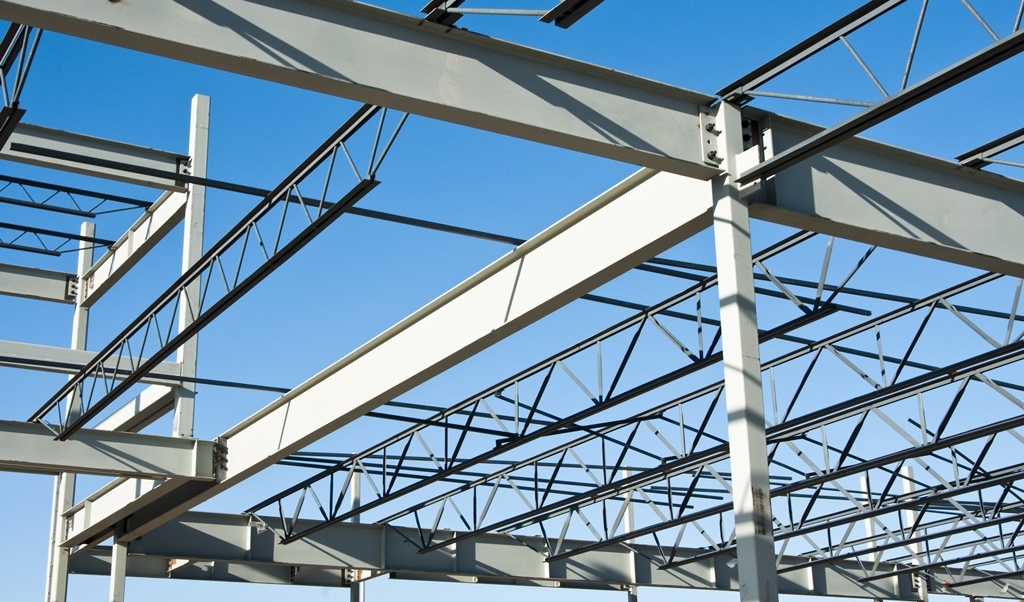ADVANTAGES OF STEEL AS A MATERIAL
Physical properties of steel
The physical properties of steel are characterized by high strength, stiffness, reliability as a consequence of homogeneity, isotropy, integrity, lightness, maintainability and recyclability of the material.
The reliability of steel structures is due to the homogeneous structure of the material and, as a consequence, integrity and high predictability of mechanical characteristics. Steel has a large elasticity modulus — 2.06 * 105 MPa (for comparison — this is 7 times more than for concrete of C25/30 class), a homogeneous fine grain structure, which retains the same properties in all directions (isotropy), and provides deformation of the material by the linear dependence type (Poisson's ratio ν = 0.27 ÷ 0.30). In practice, this allows to determine the behavior of steel structures under high accuracy load and to use the material as efficiently as possible.
Steel, like most metals, has a high density (= 7.78.1 g/cm3), which makes products made of it impermeable to most aggressive liquids and gases. And this, in turn, allows to create high-strength steel products for all industries due to reliable welded joints. These can be gasholders, industrial tanks, pipelines, medical equipment, various devices and vessels for the food, pharmaceutical, medical industry, etc.

Steel products not protected from moisture in combination with salts, corrosive gases and dust suffer from corrosion. High corrosion resistance of steel structures in modern production conditions is achieved by adding specialized alloying additives in the basic composition of steel and regular coating of the surface of structures with protective compounds. Steel is resistant to biological influences, humidity and temperature influences, which allows steel structures to be extremely durable.
Due to the high strength to density ratio, metal structures are the lightest of the existing structures today, which significantly reduces the load on the bases and foundations, reduces construction work cost and increases the speed of construction. For comparison, steel C245 has a strength to density ratio of 3.06 kN * cm/g, while concrete of C20/25 class — 0.58 kN*cm/g.
Low environmental impact of steel. Compliance with the sustainable development principles
The concept of sustainable development is based on the principle of a balance between meeting modern needs and protecting the interests of future generations. The theory of sustainable development is an alternative to the paradigm of economic growth, which ignores the environmental component. The environmental component of sustainable development involves the optimal use of limited resources and environmental technologies aimed at reducing greenhouse gas emissions to slow down global warming. And the economic component involves the optimal use of limited resources and environmental energy and material-saving technologies, including production and processing of raw materials, production of environmentally friendly products, minimization, processing and disposal of waste.
The share of the construction industry in CO2 emissions is 11% of global emissions as a result of human life and activities. At the same time, more than 90% of emissions in the course of construction fall to the production of construction materials, and only 10% are related to the construction works. Therefore, the environmental component of sustainable development in construction focuses on the maximum use of natural raw materials, which can be completely recycled and reused, as well as solutions reducing the environmental impact.
Due to their lightness, durability, reusability and recyclability, the use of steel structures meets the sustainable development principles. Metal structures retain their properties throughout the entire life cycle of the building. After its expiration, the load-bearing elements can be reused in other structures, and, in the event of moral and physical wear, they are removed and recycled, which is not only environmentally friendly, but also provides a return to the owner.
Recycling and reuse of steel reduces the environmental impact by more than 2 times. A steel frame is recycled by 98%, it is melted and is used again not only in the construction but also in other sectors. The use of recycled raw materials in the productions of steel can significantly reduce emissions. In the EU, 50% of steel is produced from scrap metal, and some grades involve 98% of recycled raw materials. The use of structures made of high-strength steel can reduce its consumption and, consequently, emissions, as well as the cost of the frame.
Economic (LCC) and environmental (LCA) assessment of the life cycle of buildings are an assessment tool for conformity to sustainable development principles. These tools involve determining the value of the building and the amount of emissions for all stages of its life cycle (from construction to demolition).
It is the complex, primarily economic benefits and involvement of elements of sustainable development in the analysis that have determined the changes in the ratio of the use of structural building materials in leading countries in favor of steel frames in the past decade.
